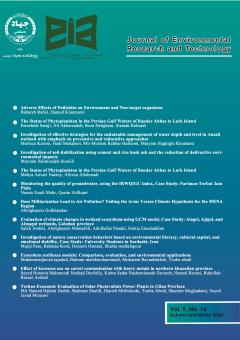Ecosystem resilience models: Comparison, evaluation, and environmental applications
Subject Areas : برنامه ریزی؛ آموزش و مدیریت محیط زیستمحمد جواد تجدد 1 * , Bahram Malek Mohamadi 2 , mokarram ravanbakhsh 3 , طوبی عابدی 4
1 - 1- Research Expert, Department of Natural Environment, Environmental Research Institute, Academic Center for Education Culture & Research (ACECR), Rasht, Iran.
2 - 2- Associate Professor, Department of Planning, Environmental Management and HSE, Faculty of Environment, University of Tehran, Tehran, Iran
3 - 3- Assistant Professor, Department of Natural Environment, Environmental Research Institute, Academic Center for Education Culture & Research (ACECR), Rasht, Iran
4 - Assistant Professor, Department of Natural Environment, Environmental Research Institute, Academic Center for Education Culture & Research (ACECR), Rasht, Iran
Keywords: Phytoplankton, Per Ecosystem, Resilience, Modeling, Environment,
Abstract :
Ecosystem resilience is defined as the capacity of an ecosystem to resist and recover after natural or human-induced disturbances and threats. This paper compares and evaluates different ecosystem resilience models and examines their environmental applications. The models are categorized into four groups: theoretical, statistical, agent-based, and hybrid models. The performance and effectiveness of each model are assessed in response to various environmental changes and threats. Furthermore, the environmental applications of these models in conserving and managing natural resources, improving environmental quality, and promoting sustainable development are reviewed. This paper also explores the related concepts and their connection to resilience, elaborates on the concept of ecosystem services and its relationship with resilience, and analyzes the InVEST software along with a case study. Based on the comparisons, no single model can be considered the best under all circumstances. The selection of an appropriate model depends on the research objectives, the type of ecosystem under study, and the availability of data.
1) اسدالهی، ز،. سلمان ماهینی، ع،. میرکریمی، ح،. السادات عظیمی، م. 1395. بررسی اثر تغییر کاربری اراضی بر عرضه خدمات زیستگاهی با نرم افزار InVEST . علوم و تکنولوژی محیط زیست.#
2) نوریان، محمد مهدی، (1401)، ارزيابي تابآوری تالاب ها در مناطق خشک و نیمهخشک با کاربرد مدلسازي خدمات اکوسیستمی (مطالعه موردی: تالاب پریشان). پایان¬نامه کارشناسی ارشد. دانشگاه تهران. دانشکده محیط زیست.#
3) Taleb, N. N. (2014). Antifragile: Things that gain from disorder (Vol. 3). Random House Trade Paperbacks. https://cmc.marmot.org/Record/.b42507212#
4) Williams LRR, Kapustka LA. (2000). "Ecosystem vulnerability: a complex interface with technical components", Environ Toxicol Chem; 19:1055-8.#
5) Dou, Z., Stefanovski, D., Galligan, D., Lindem, M., Rozin, P., Chen, T., & Chao, A. M. (2021). Household food dynamics and food system resilience amid the COVID-19 pandemic: A cross-national comparison of China and the United States. Frontiers in Sustainable Food Systems, 4, 577153.#
6) Chao, W. (2021, June). Research on sponge city planning based on resilient city concept. In IOP Conference Series: Earth and Environmental Science (Vol. 793, No. 1, p. 012011). IOP Publishing.#
7) Folke, C.; Carpenter, S.; Walker, B.; Scheffer, M.; Elmqvist, T.; Gunderson, L. & Holling, C. S. 2004. Regime shifts, resilience, and biodiversity in ecosystem# management. Annual Review of Ecology, Evolution, and Systematics, 557–581.
8) Holling, C. S. (1973). Resilience and stability of ecological systems.#
9) Mcdonald, R. I. 2009. Ecosystem service demand and supply along the urban-to-rural gradient. Journal of Conservation Planning, 5, 1–14.#
10) Sharp, R., Chaplin-Kramer, R., Wood, S., Guerry, A., Tallis, H and Taylor, R. 2014 InVEST User’s Guide: Integrated Valuation of Environmental Services and Tradeoffs (Stanford, CA: The Natural Capital Project) p 321.#
11) Teeb, 2011. TEEB manual for cities: Ecosystem services in urban management. The Economics of ecosystems and biodiversity (TEEB).#

